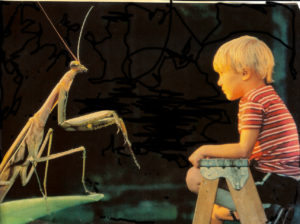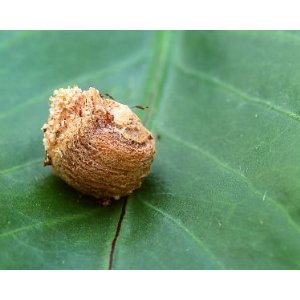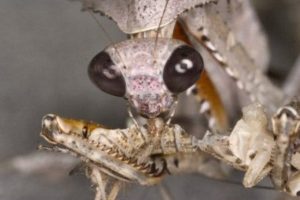
This is a mantid. Recently I captured a mantid in my garden and put it in the terrarium in the classroom for the children to watch. You must feed them bugs and they are voracious eaters. We caught some grasshoppers today and the mantis loves ants. We put a sponge soaked in water in the tank or you may give it a spray of water on the glass. I will return home to my garden soon.
Two or more of these insects are called mantids. They are close relatives of cockroaches and stick insects. An adult mantis can get 13 cm long – about 12 inches. They have a head shaped like a triangle and a long “neck”, the thorax. They are the only insect that can turn its head 180 degrees from side to side without moving the body. The forelegs have sharp spines on them for catching prey and they always bite the neck first. Mantids keeps the forelegs folded and held together as if praying.
Mantids are usuall green or brown and easily camouflaged on leaves and stems. One kind of mantis is pink. They have wings but are very poor at flying and walking.They like to sit and wait for their prey.When prey comes close, they are very fast with their forelegs to catch it. The reflex of their forelegs is so fast it is difficult for our eyes to see them grab a meal. Mantids are voracious eaters and are carnivores only eat animals such as bees, beetles, moths, butterflies, aphids, crickets, flies, and other insects. They are cannabalistic and will eat other mantids or their mate. The female is famous for biting the head off of the male after mating. Large adult mantids may even eat small birds, frogs or lizards. They are solitaary hunters with biting and chewing mouth parts.
Mantids molt or shed their exoskeleton to grow larger. They have 2 large sensitive compound eyes that can tell if something moves 60 feet away.with 3 simple eyes between them. The mother mantid lays several hundred eggs in an egg case made from a frothy secretion that hardens to protect the eggs. The egg case can withstand severe winter weather and hatches after about 8 weeks of warm weather. A mantis may lay several egg cases usually attached to twigs, leaves, or fences.. The egg case will hatch the following spring and about 200 tiny nymphs that look very much like adults will crawl from betwween tiny flaps in the egg case and hang from silken threads to dry out. The egg case does not change appearance in any way.
Mantids are harmless to humans and they can become tame enough to eat insects from your fingers. The praying mantis is considered diurnal meaning they are most active in the day time, but sometimes you can see them flying around at night. Their average life span is 1 year.


THE ORCHID MANTIS!

FLOWER MANTIS




